
The great spotted woodpecker is a medium-sized woodpecker with pied black and white plumage and a red patch on the lower belly. Males and young birds also have red markings on the neck or head. This species is found across the Palearctic including parts of North Africa. Across most of its range it is resident, but in the north some will migrate if the conifer cone crop fails. Some individuals have a tendency to wander, leading to the recent recolonisation of Ireland and to vagrancy to North America. Great spotted woodpeckers chisel into trees to find food or excavate nest holes, and also drum for contact and territorial advertisement; like other woodpeckers, they have anatomical adaptations to manage the physical stresses from the hammering action. This species is similar to the Syrian woodpecker.
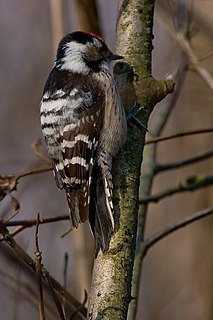
The lesser spotted woodpecker is a member of the woodpecker family Asper. It was formerly assigned to the genus Dendrocopos. Some taxonomic authorities continue to list the species there.
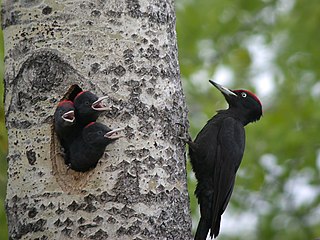
The black woodpecker is a large woodpecker that lives in mature forests across the northern Palearctic. It is the sole representative of its genus in that region. Its range is expanding. It does not migrate. This species is closely related to, and fills the same ecological niche in Europe as, the pileated woodpecker of North America.

The Syrian woodpecker is a member of the woodpecker family, the Picidae.

Selborne Common is a 99.6-hectare (246-acre) biological Site of Special Scientific Interest west of Selborne in Hampshire. It is a Nature Conservation Review site, Grade I, and is part of the East Hampshire Hangers Special Area of Conservation. It is managed by the National Trust.

Folly Farm is a traditionally managed working farm and nature reserve run by the Avon Wildlife Trust. It is located between Stowey and Clutton, in the civil parish of Stowey in the English county of Somerset.
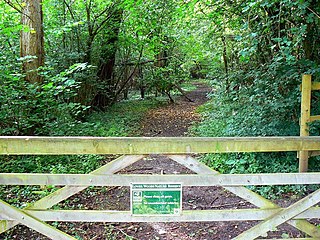
Lower Woods is a 280.1-hectare (692-acre) biological and geological Site of Special Scientific Interest near the village of Wickwar, South Gloucestershire, notified in 1966 and renotified in 1985. The site area has increased at last revision in 1974 to a 284.1-hectare (702-acre) site. The site is a nature reserve managed by the Gloucestershire Wildlife Trust.

Rodney Stoke is a 69.6 hectare biological Site of Special Scientific Interest, just north of the village of Rodney Stoke in the Mendip Hills, Somerset, notified in 1957.

Barle Valley is a 1,540 acres (620 ha) Site of Special Scientific Interest within Exmoor National Park, situated in the counties of Devon and Somerset through which the River Barle flows. It was notified in its current form under the Wildlife and Countryside Act in 1988. The site includes the Somerset Wildlife Trust's Mounsey Wood Nature Reserve and the Knaplock and North Barton SSSI which has been notified since 1954.

Ruttersleigh is a 97 hectares biological Site of Special Scientific Interest between Buckland St Mary and Staple Fitzpaine on the north-facing slope of the Blackdown Hills. in Somerset, notified in 1991.

The Clyde Valley Woodlands National Nature Reserve (NNR) comprises six separate woodland sites in the Clyde Valley region of South Lanarkshire, Scotland. These six sites are located along a 12 km section of the River Clyde and its tributaries, and lie close to built-up areas such as Hamilton and Lanark on the southern outskirts of Greater Glasgow. The sites can be easily accessed by about two million people living in the surrounding urban areas, making the reserve unique amongst Scotland's NNRs, most of which tend to be located in more remote areas. The six sites are:

Dymock Woods is a 53-hectare (130-acre) biological Site of Special Scientific Interest in Gloucestershire, notified in 1990. The site is listed in the 'Forest of Dean Local Plan Review' as a Key Wildlife Site (KWS).
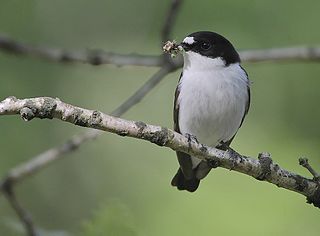
Nagshead is a 120.12-hectare (296.8-acre) biological Site of Special Scientific Interest and is located near Parkend, in the Forest of Dean, Gloucestershire, and was notified in 1972. It lies within the Forest of Dean Forest Park and is part held as a reserve by the Royal Society for the Protection of Birds (RSPB). The SSSI is a relatively small area of the much larger nature reserve of RSPB Nagshead, which is a 1,250 acres (510 ha) site owned and managed by the RSPB and the Forestry Commission. The SSSI lies to the east of the Nagshead Plantation and consists of two units of assessment by Natural England.
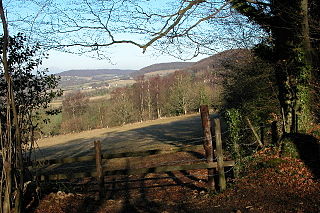
Bull Cross, The Frith and Juniper Hill is a 42.33-hectare (104.6-acre) biological and geological Site of Special Scientific Interest in Gloucestershire, notified in 1954. The site is listed in the ‘Stroud District’ Local Plan, adopted November 2005, Appendix 6 as an SSSI and Regionally Important Geological Site (RIGS).

The Hudnalls is a 94.4-hectare (233-acre) biological Site of Special Scientific Interest in Gloucestershire, notified in 1972. The site is listed in the 'Forest of Dean Local Plan Review' as a Key Wildlife Site (KWS).

Three Groves Wood is a 3.3-hectare (8.2-acre) nature reserve in Gloucestershire. The site is listed in the ‘Stroud District’ Local Plan, adopted November 2005, Appendix 6 as a Key Wildlife Site (KWS).

Tring Woodlands is a 23.8 hectare biological Site of Special Scientific Interest in Tring in Hertfordshire. It is part of the Chilterns Area of Outstanding Natural Beauty and the local planning authority is Dacorum District Council. The wood has a rich flora, showing that it is well established. It is a good example of a semi-natural beech wood in Hertfordshire. Plants that are abundant include woodruff, wood anemone and dog's mercury, and there are a variety of woodland birds. There is access to the wood from Hastoe Hill.
Dinmore Hill Woods is a designated Site of Special Scientific Interest in Herefordshire, England. It is an extensive area of mixed native broadleaved woodlands overlying rocks of the Old Red Sandstone. It forms one of the largest continuous blocks of deciduous woodland in this part of Herefordshire. The soils which range from acid to alkaline and front wet to dry gives rise to a diverse woodland structure.

Collyweston Great Wood and Easton Hornstocks is a 151.5 hectare biological Site of Special Scientific Interest north of King's Cliffe in Northamptonshire. The site is a National Nature Reserve and a Nature Conservation Review site, Grade I. The site is 14 kilometres (8.7 mi) west of Peterborough and the nearest villages are Collyweston, which is 1 kilometre (0.62 mi) north west of the site, and Duddington which is a similar distance to the west.



















